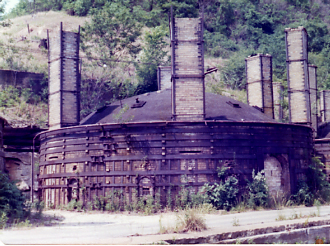
A kiln at Dando Brick.
Click Here to Return to Milestones
The following history by Charles Townsend first appeared in the book Industry, PA: Sesquicentennial 1856-2006
Dando Brick Yard was an important Industry
business for many years. Dando made a superior quality firebrick
for furnaces and kilns. Its customers included J&L, Bethlehem
Steel, B&W, Crucible Steel, various foundries and potteries,
and many other industries in a 400-mile radius.
The owner was George Dando of Beaver, and the brickyard was built in 1915. It had 26 kilns capable of holding 80,000 to 90,000 bricks. The shop had five large brick making presses, and each press would make different sizes of bricks. These five presses could make 12,000 bricks per day. It employed between 90 and 103 men. The men got paid in relation to how many bricks they could produce; there was not a daily salary. There was a railroad spur into the plant, and the bricks were shipped by both train and truck. The coal for the kilns was not mined on site, but was shipped in by rail to the plant.

Mules were first used in the mine, but later
horses were substituted. The mine was an incline mine 5 to 6 miles
long, so long in fact, that it went under Tuscarawas Road in Brighton
Township. Some of the rooms went to 40 feet in height.
The workmen, before going out for the day,
dynamited the clay so that the dust would settle before they returned
the next day. A workman would set the explosives at both an upper
and lower level on the wall of clay. He would jump on the "motor"
with his fellow workers and head for the entrance. As they made
for the entrance, they would hear and feel the blast.
Nick Yanosich, the Mayor of Industry, was
born and raised in the company houses at Dando Hollow. As a boy
of 16, he worked after school unloading the coal cars. One night
he was allowed to go back into the mine with Mr, Lacey, the Superintendent,
to check on the dynamited clay to make sure it was ready for loading
the next day. It was one of his most memorable experiences. They
used carbide lamps, and when the lamps were turned off, he experienced
the most profound silence and darkness of his life.
Clay was processed first to a small size,
and then another process reduced it into even smaller particles.
It was then mixed with water, and was put into a machine that
formed the bricks.
The prepared bricks were loaded into the
kilns. The first day in the kilns was referred to as a "smoking
day," as it allowed time for the wet bricks to start to dry
off so that the main firing could begin.
In the early days, the kilns were fired
by coal, and a specific temperature was maintained by closely
monitoring the kilns. After Yanosich returned from the service,
he discovered that Dando had switched to gas, which was cleaner
and easier to regulate.
Arnold McMahon remembered, "After a
kiln of bricks was fired, the spent hot ashes were carted across
the railroad tracks and dumped over the bank adjacent to the highway.
Many have moved their car up close to the hot ashes and warmed
themselves and the interior of the car, on a cold winter night
in the early thirties. Ah! Sweet memories!"
In 1978 Dando was forced to shut down due
to Pennsylvania pollution standards. The operation was moved to
Ohio which had more lenient standards.
Nick Yanosich clearly remembers life in
Dando Hollow. The company houses were built from company bricks,
the only time Dando bricks were used for construction.
Fourteen families lived there as well as
several borders. Each house cost $25 a month to rent.
Around 1929, before Nick's father was married,
Mr. Dando gave him $2,500 dollars and asked him to go over to
Yugoslavia and bring back some workers. His father brought back
6 workers, who from 1930 to 1955 worked at the plant, sending
back money to their families at home. In 1955 they retired and
returned home, relatively rich men.
There was no running water in the company
houses until 1945 when Mr. Dando put in a pump house with two
pumps. (Before that, residents carried water from a spring house.)
The water was pumped into a holding tank and then into the homes.
In the wintertime, each resident had to keep the water dripping
so that the lines wouldn't freeze. Dando also eventually put in
a septic system.
Nick remembers that his family kept four borders and that, in the early days, the house was heated by radiant heat from a first floor stove. In the 1940's
Mr. Dando put a furnace into each house.
There was a vein of coal in the mine, so Dando would have workmen
mine some of the coal and send it down a chute toward the homes.
The boys of the village took turns wheeling the coal from the
pile to the homes. They might earn 5 or 10 cents a load from the
grateful residents.
In 2004, the current owner had to bulldoze the old houses down, because wayward youth were using them for nefarious purposes.